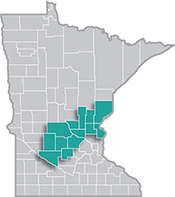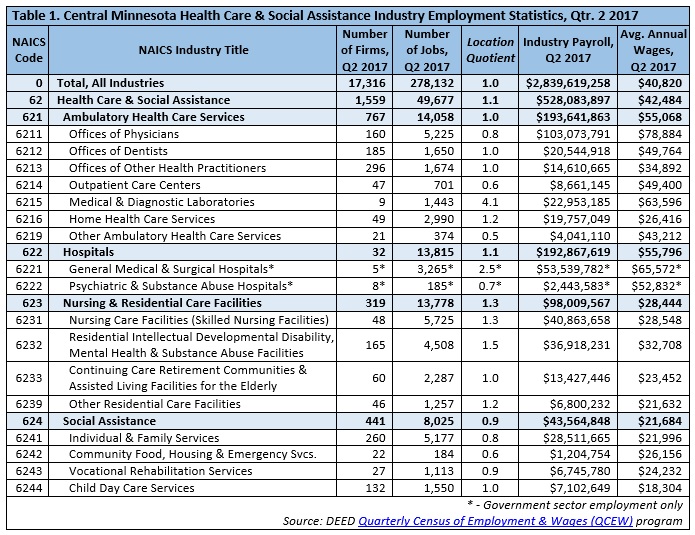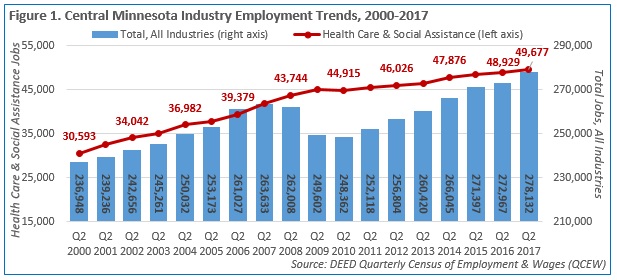 Central Minnesota is a manufacturing stronghold, with several global manufacturing firms operating there.
Central Minnesota is a manufacturing stronghold, with several global manufacturing firms operating there.
The region is especially well known for its expertise in food processing, printing, furniture manufacturing, appliances, machinery and heavy equipment manufacturing.
View our latest blogs on CareerForce. Want the freshest data delivered by email? Subscribe to our regional newsletters.
3/27/2018 10:09:32 AM
Luke Greiner
The 13-county Central Minnesota region was home to 1,559 health care and social assistance establishments providing 49,677 jobs in the second quarter of 2017, according to DEED's Quarterly Census of Employment and Wages (QCEW) data.
The sector accounted for 17.9 percent of total employment in the region, easily making it the largest employer in the region, well ahead of manufacturing (41,678 jobs) and retail trade (36,222 jobs). Statewide, 17 percent of jobs are in health care and social assistance, meaning health care is slightly more concentrated in Central Minnesota.
These health care and social assistance providers paid out $528 million in quarterly payroll in 2017, making it the second largest sector payroll, just behind manufacturing. Average annual wages in health care and social assistance were $42,484 in 2017, which was slightly higher than the total of all industries, but varied widely based on the subsector and industry (Table 1).

Despite economic fluctuations in the region across other industries, health care and social assistance providers in Central Minnesota have continually added jobs over the past 17 years. Health care and social assistance accounted for 12.9 percent of total jobs in the second quarter of 2000, but after gaining just over 19,000 jobs from 2000 to 2017, the industry now comprises 17.9 percent of total employment. While the number of jobs across the total of all industries expanded 17.4 percent from 2000 to 2017, the health care and social assistance industry jumped 62.4 percent (Figure 1).

Health care and social assistance has become an increasingly important part of Central Minnesota's economy over the past decade, adding 7,705 net new jobs from the second quarter of 2007 to the second quarter of 2017, an 18.4 percent rise. That was just over half of the total new jobs added in the region over the past 10 years across all industries. And though the health care industry saw slower growth than the total of all industries in the past year, it has still been the largest job contributor in the region since 2000.
Despite a loss of 544 jobs in the past year, ambulatory health care services experienced the largest and fastest increase in jobs over the past decade, adding 4,043 net new jobs from the second quarter of 2007 to the second quarter of 2017. Home health care services saw the biggest jump, adding 1,045 jobs, a 54 percent increase, followed by offices of physicians, which gained 824 jobs, and medical and diagnostic laboratories, which expanded by more than 1,000 jobs since 2012.
Social assistance providers added almost 1,500 jobs over the past decade, primarily at individual and family services, while vocational rehabilitation services actually lost 516 jobs. The region's nursing and residential care facilities gained 1,111 net new jobs, with huge gains at both continuing care retirement communities and other residential care facilities offsetting job losses at nursing care facilities and developmental disability, mental health, and substance abuse facilities. The region's hospitals also gained 1,060 net new jobs since 2007, including a huge increase in the past year.
Contact Luke Greiner at 320-308-5378.